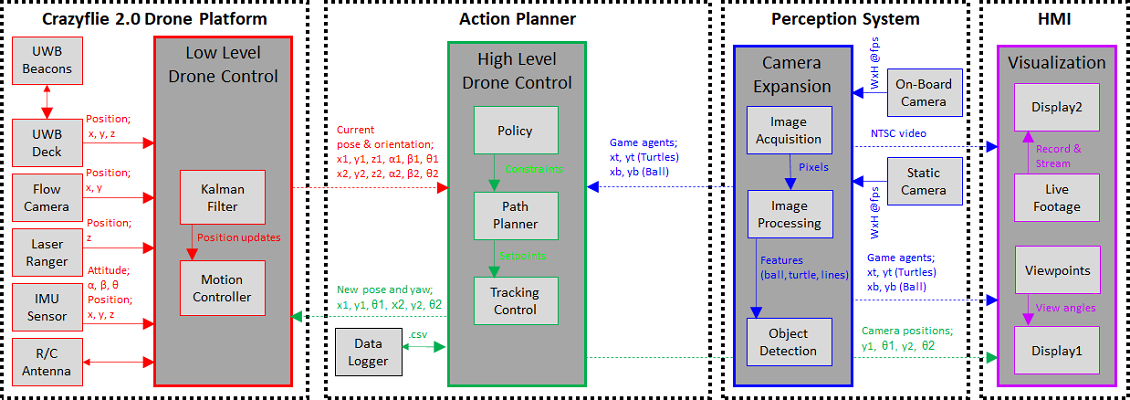System Architecture MSD19
Architectural Framework
Autonomous drone referee system architecture has been implemented by taking into account both CAFCR[1] and SafeRobots[2] frameworks. The focus in the project has been heavily concentrated towards the design and implementation having derived the requirement specifications and hardware resources available. As a tailored approach to our goal, the team developed the system-level reasoning based on abstract knowledge defined in the problem space. These were the requirements chosen to be the most critical, the context of the problem and which problems we strive to address the most. Then design choices were made based on thereof to define the solution space consisting of hardware and other tools to utilize, algorithms for path planning and communication protocols. This namely was the design time and opportunity to mitigate uncertainties. The operational space covers the process of developing tangible deliverables that satisfy functional and non-functional requirements that were initially prescribed.
The overall methodology of our roadmap can be found in the table below:
Problem Space
- Requirement 1: Develop a safe system that will not cause damage or harm in case of malfunction
- Requirement 2: Choose a solution that will enable to develop the project from simple to complex
- Requirement 3: Formalize solution such that it can be transferrable to future work
- Context 1: Drone platform and display
- Context 2: Robot soccer MSL
- Problem 1: How to track a ball for a referee such that they can make clear decisions
- Problem 2: How to design a system using low computational resources
Solution Space
- Perception: Computer vision, Deep NN
- Navigation: Path planning in 1D, Path planning in 2D
- Platform: Crazyflie, Sensors, Camera, Power
- Communication: UWB, Radio
Operation Space
- Middleware: ROS, Crazyflie
- External Code Libraries: Craztflie_lib, OpenCV, libraries in Python
- Implementation: Executable software code, Virtual simulation
- Deployment: Model tests, hardware tests, software debugging
System Decomposition
In this section we develop our hypothetical framework that covers the entire strategy for the drone referee system and later conclude with the realised version. The essence in both models is that they give perspective of how each component interacts with one another when the system is operational. The system is operational when the drone platform is in flight under a controlled manner to detect and track the ball in the play area of the Tech United soccer field. Furthermore, when the gameplay is visualised in the simulated environment showing what the drone captures. The system decomposition is outlined in the following sub-sections.
Ideal Strategy
The strategy of the project prompted us to fuse 4 component groups;
- Crazyflie 2.0 Drone Platform: A drone platform which carries out the mobile tasks, capable to control autonomously.
- Action Planner: Generates kinematic parameters provided to drone and into the Visualizer concurrently.
- Perception: Streams and processes images for an HMI and incorporates perception functions.
- HMI: Virtually plays the game and visualises according to given motion commands. Provides game footage.

Realised Strategy
The realised system however at its state can also perform autonomous flight and simulation without using perception. Although perception has been developed and tested successfully it has not been fully integrated with the design pipline. Therefore we present the following components in the current prototype;
- Crazyflie 2.0 Drone Platform: A drone platform which carries out the mobile tasks, capable to control autonomously.
- Action Planner: Generates kinematic parameters provided to drone and into the Visualizer concurrently.
- HMI: Virtually plays the game and visualises according to given motion commands.

Layered System Hierarchy
Based on the aforementioned architectures, the system was tested at various stages ensuring at each layer of abstraction the design is sufficiently developed. Hierarchy between each layer indicates the functionalities needed to achieve the requirements of the design[3]. Enabling the lower layers to use information obtained from upper layer. Decisions taken for team division, coordination and work packages were accordingly mapped with milestones and deadlines to handle the items at each layer as project progressed. A selection was made in the workflow on the priority for which every functionality contributes towards as seen below. Several functions more of which regarding perception together with the hardware integration of this function and integration with navigation is part of our future work.

References
[1] Muller, Gerrit. 2018. System Architecting, vol. 18, Gaudí Systems Architecting, http://www.gaudisite.nl
[2] Ramaswamy, Arunkumar et al. “SafeRobots: A model-driven Framework for developing Robotic Systems”. 2014 IEEE/RSJ: 1517-1524.
[3] Maier, Mark W. 2009. The Art of Systems Architecting, 3rd Edition. Hoboken: CRC Press. p164